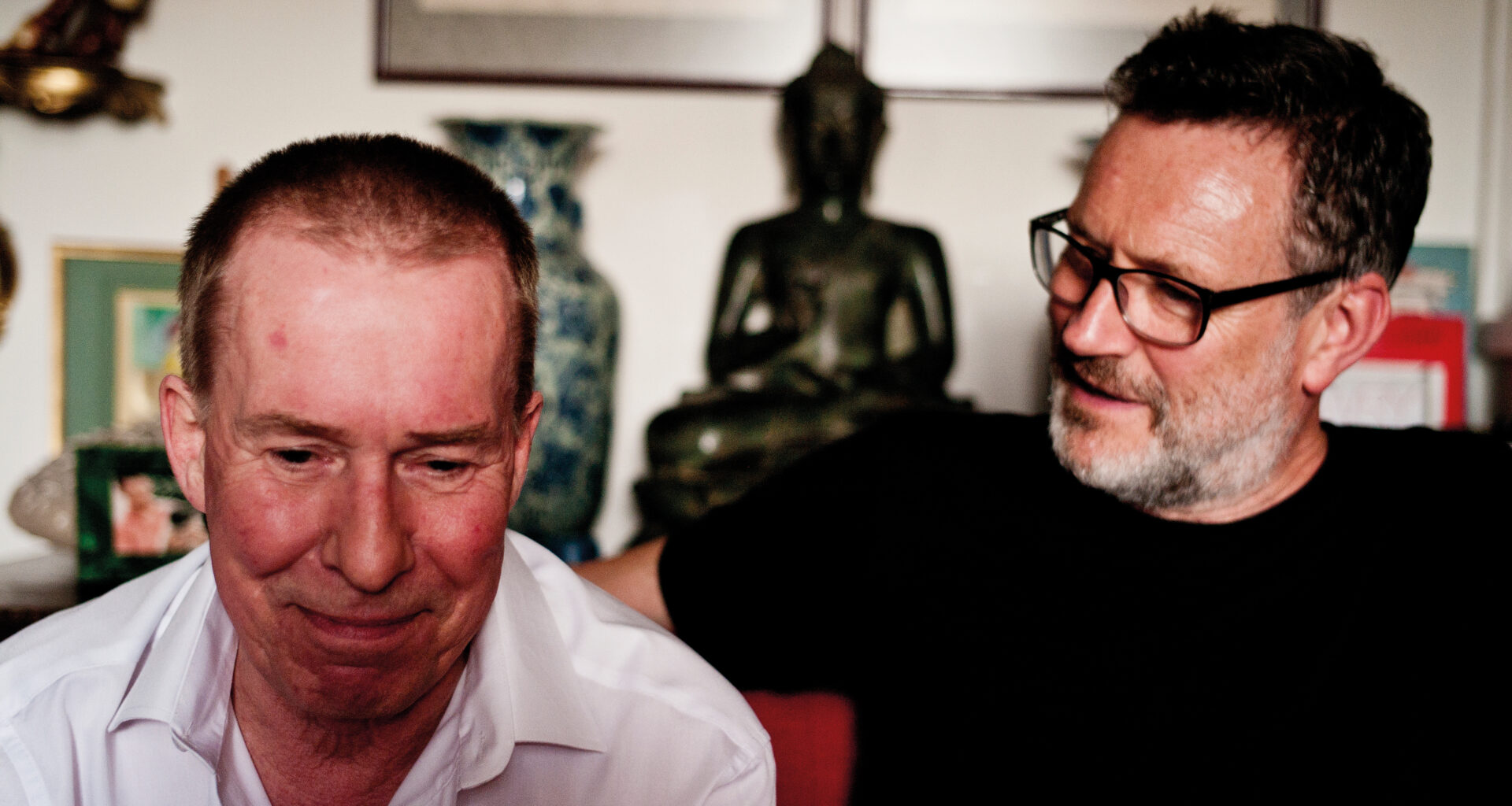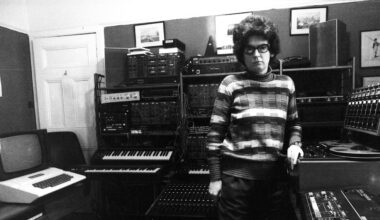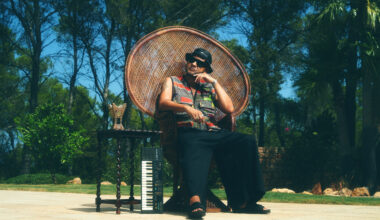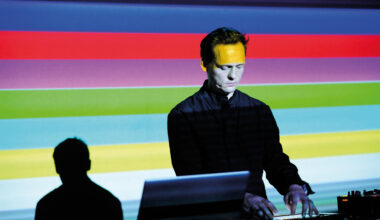Purloined from boxes of old cassettes and reel-to-reels, Blancmange are re-releasing their trio of 1980s albums – AND with bonus tracks galore. Let the original line-up of Neil Arthur and Stephen Luscombe entertain you
Today, this is truly the job that does itself. It’s early summer and in a flat on a quiet Notting Hill backstreet, with the windows open and the sound of a nearby school playground drifting in, all I need do is turn my recorder on, sit back, and enjoy the chatter…
“… and in the next cell were these massive skinhead blokes, painting delicate little watercolours! Next morning, we got up, and what was for breakfast? Tomatoes, tomatoes and tomatoes, all piled up. This is Guernsey, you know. They’ve got a tomato museum there. They live on tomatoes.”
Stephen Luscombe, whose place this is, ferries steaming cuppas from the kitchen while batting conversation backwards and forwards with his erstwhile partner in crime Neil Arthur.
“We went to see This Heat playing at the ICA. What’s he called? Charles Bullen. He played with his back to the audience for ages, and when he turned round, there was this noise, brrrrrrrrrrrr, and he had this vibrator in his hand. It was a great big willy!”
Hang on… Neil Arthur? Stephen Luscombe?
It is indeed the original Blancmange line-up. For one afternoon, the band is back together. When most bands split, acrimony is never too far away. Not with Blancmange, though. This is no long-lost reunion.
“We last saw each other a few weeks ago,” says Neil. “We speak quite a lot on the phone, and exchange far too many texts and email messages! The first thing I said when I came in was, ‘How are your herbs?’. He sends me pictures of his herb plants…”
“I’m very pleased with my herbs,” beams Stephen, settling down for the chat, his tea in a ‘Happy Families’ mug from the olden days no less.
Between 1982 and 1985, Blancmange released three albums – ‘Happy Families’, ‘Mange Tout’ and ‘Believe You Me’. The whole lot are about to get reissued as a deluxe nine-disc, 132-track boxset, with a feast of extras including demos, sessions, unreleased tracks and live recordings.
‘The Blanc Tapes’ has been several years in the making, with boxes of old tracks and demos pouring forth from Neil Arthur’s cupboards, where they’ve sat, unheard, for decades.
“A couple of times I’ve said, ‘Right, I’m going down the dump with this lot’,” he notes. “There were boxes and boxes of cassettes and reel-to-reel tapes. Each time I found something, I sent it over to Stephen to have a listen. I’d say, ‘Do you remember this piece?’, and he’d say, ‘Oh, bloody hell, this is from then’.”
‘The Blanc Tapes’ not only highlights Blancmange’s raft of pop hits in all their demoed and remixed glory, it also shows off their much more experimental side, which leads you to wonder how they got tangled up in pop stardom. Accidentally seems to be the answer. Perhaps the daft name didn’t help.
“I think the name got rooted with the photo of the two old ladies in that launderette for ‘Irene & Mavis’,” says Stephen of the cover artwork for their 1980 debut EP. “I thought, ‘He’s Mavis, I’m Irene’, and we still call each other that now. Mavis Secostas, Irene “Disco” Sinden. It’s like Hinge and Bracket.”
“The conceit was we were in the background helping the two old dears do this music, experimenting with tape loops, and it just seemed to be perfect,” says Neil. “It was that Dadaist thing. We were saying, ‘Well, it doesn’t really matter what it’s called’, not thinking we would still be answering questions about it several decades later.”
“It all went wrong,” laughs Stephen. “We didn’t mean it, we really didn’t really mean it.”
Disposable pop puppets Blancmange were clearly not. When you poke around, you discover they were formed out of something much more interesting than a desire to dominate the Top 40.
“I had my own music workshops that sort of morphed into this punkish band,” says Stephen. “We were called MIRU, Music Improvisation Research Unit. We used to find things like washing machines and lawnmowers, which we used along with conventional instruments. We did songs like ‘These Boots Are Made For Walking’ and ‘Catch A Falling Star’, as well as our own material. There was improvised stuff too, sort of squeaky gate music.”
And all this was inspired by what, I wonder?
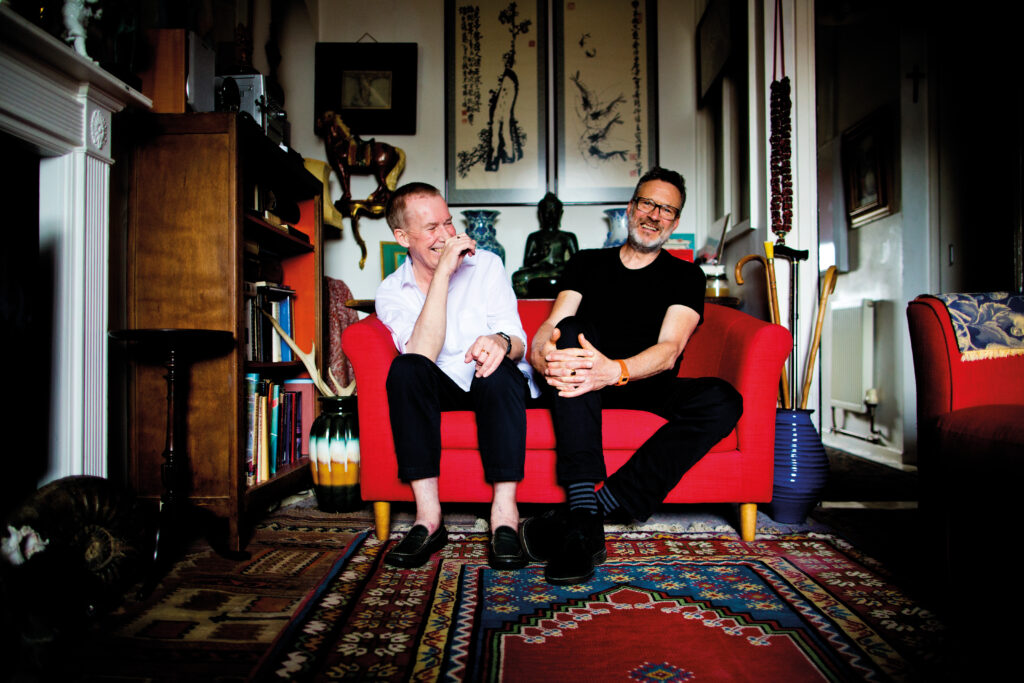
“I used to be in an orchestra called the Portsmouth Sinfonia,” reveals Stephen, referring to the experimental outfit which counted Brian Eno (on clarinet) among their alumni. Founded by Gavin Bryars at Portsmouth School of Art, the scratch orchestra encouraged anyone to join, no matter their level of ability, which led to a, erm, unique sound. The 1974 album ‘Portsmouth Sinfonia Plays The Popular Classics’, produced by Eno, is quite a treat.
“The whole point was it didn’t matter, you just had to try your best,” explains Stephen. “We ended up playing the Royal Albert Hall and Leonard Bernstein wanted us to go to Carnegie Hall in New York…”
Stephen played second violin and, on a scale of one to 10 ability-wise, claims he was somewhere in the middle. I can’t help cracking a joke about him playing second fiddle, but that fiddle got him places.
When Eno began work on his second solo album, ‘Taking Tiger Mountain (By Strategy)’, Stephen got a call saying he wanted a string section to play on the track ‘Put A Straw Under Baby’.
“I was about 18 at the time and I’d never been in a studio before, so I was dead nervous,” continues Stephen. “When I got there, I said, ‘Where’s everybody else?’. There were only four of us… we were the band! Robert Wyatt was singing on it as well, so I was chuffed to bits.”
Stephen could have probably stopped there, quit while he was ahead, but his workshops and the MIRU shows were calling.
“I was working in graphics and printing, a proper job, but my friend Robert was at the same college as Neil in Harrow.”
“I’d go along to see Stephen’s band in the college bar,” says Neil. “I saw them a few times, once with a washing machine, and another time there was a Hoover with a saxophone connected to it. We’d have a pint afterwards.”
Neil’s own band, The Viewfinders, were also starting to gig. They did covers of Shirley Bassey, Roxy Music, Frank Zappa and the like, as well as a few of their own cacophonous numbers. None of them really sounded like songs. Their early audiences, it seems, had a love/hate thing for them.
“The second time we played, we saw a guy down the front with a gun,” says Neil. “Bruce the barman got involved and said, ‘You can’t have a gun in here, why have you got a gun?’, and this guy said, ‘I saw them the first time’.”
Neil and Stephen seemed to be on the same trajectory, but it took them a while to get round to making music together. Stephen was busy with work, Neil was studying, and they were both occupied with their respective bands, but eventually Neil began heading to Stephen’s place in Hayes for impromptu weekend recording sessions.
Neil had a guitar, a Gibson SG copy he’d bought off a mate for £18, and a battery amp he’d made when he was at school, while Stephen had an organ. Not a synth, an organ. They borrowed a tape recorder and a Wem Copicat tape echo unit, and they’d use Tupperware boxes and silver foil for drums. It was all tickled along with a collection of BBC sound effects LPs for assorted noises.
There is, apparently, a slowed down gorilla sample on ‘I Can’t Explain’, which is almost as good as the story put about by The Radiophonic Workshop that the TARDIS noise is the sound of mating hippos slowed down. The results were soundscapey, basic instrumentals that would on occasion feature Stephen talking over the top.
“And then one day, you started singing,” recalls Stephen, pointing a finger at Neil. “I’m making all these horrible noises and you’re a brilliant singer.”
The pair drew inspiration for their formative experiments from the bands they’d see playing live in and around late 70s London. One group in particular led to the next step in their evolution.
“Young Marble Giants knocked me sideways when I first saw them,” says Neil. “Their minimal thing really made sense, so we started writing these repetitive, basic two or three-chord songs like ‘Sad Day’ and ‘Holiday Camp’. We were like, ‘Oh, this interesting’. Then I thought, ‘I’m going to put some words to something’, and we wrote ‘I’ve Seen The Word’.”
Their first recorded fling was the ‘Irene & Mavis’ EP. The self-released record had so many ideas buzzing around, you could almost hear the musical synapses popping as connections were made with the almost ravey ‘Overspreading Art Genius’, the swirling ‘Just Another Spectre’, and the melodic, tuneful ‘Holiday Camp’, which was the standout track.
The EP found its way to Some Bizarre Records supremo Stevo, who wondered what else they might have. “What about ‘Sad Day’?”, they said. Written for Neil’s partner Helen, the fact that it’s an instrumental speaks volumes about Blancmange.
‘Sad Day’ appeared on the trialblazing 1981 ‘Some Bizarre Album’ compilation alongside the likes of Soft Cell, The The and Depeche Mode. Their inclusion was like waving a great big flag. Cherry Red offered the duo a publishing deal, with a sweetener of working with Human League founder Martyn Ware on a demo. So off they went to Ware’s Sheffield’s studio, which they discovered he shared with the new version of The Human League, despite having been booted out of his own band the previous year.
With Martyn Ware’s help, Neil and Stephen put together a four-song demo that included a wonkingly awkward version of ‘Blind Vision’ (which features on the extra ‘Mange Tout’ disc), ‘I’ve Seen The Word’, ‘I Can’t Explain’ and another crack at ‘Sad Day’. With a set like that, you can see why people started falling over themselves for a piece of Blancmange. Cherry Red hawked the demo around, Stevo landed the odd gig, and promoters began to ring Neil at work.
“One day, I got this call,” says Neil. “Someone said, ‘Grace Jones wants you to come and support her’. I just said, ‘Fuck off’ and put the phone down, thinking it was one of my mates having me on.”
“It was true,” grins Stephen. “Three nights with Grace Jones. Thomas Leer had pulled out, so they asked for us instead. We went there straight from work and I said, ‘We’ve got to do something, let’s get some decent clothes, get some props, get some lights sorted out, anything to make it look half decent…”
“So we went to Oxfam, got us dead man’s suits,” laughs Neil. “And that’s when Depeche Mode got in touch.”
“We went on holiday with Vince,” says Stephen.
Excuse me. Do what?
“They came to see us with Daniel Miller before we were signed,” explains Neil. “They came to see if we wanted to support them on their tour and we got on like a house on fire.”
“So we went to Tenerife for Christmas,” says Stephen. “All we did was laugh. We used to get down the pool in the morning and Vince would be sat there with his jeans and leather jacket on.”
“We all had new Walkmans,” notes Neil. “My mum used to do the cleaning to ABBA and their singles collection had just come out, so I had the cassette and we were sharing that. Vince loved ABBA too.”

Which explains much. Vince had quit Depeche Mode and birthed Yazoo, while Blancmange began brewing their dazzling cover of ‘The Day Before You Came’. In the event, Depeche Mode and Daniel Miller proved valuable allies and Blancmange built quite a head of steam, going on to support Japan before signing a contract with London Records in February 1982.
“The day we signed was the day we both left work,” says Neil. “The next morning, we were in the studio, and that was that.”
“It was a terrible deal,” says Stephen. “We were on £60 a week with a £1,000 advance… which included making the record!”
The first fruit was a Mike Howlett session that served up ‘God’s Kitchen’ and ‘I’ve Seen The Word’, which London Records knocked out chop-chop as a double A-side. By October 1982, the band had crashed the Top 10 with their third single, ‘Living On The Ceiling’, a track from their debut album ‘Happy Families’, released a few weeks earlier. Different times, but that was three singles and an album in a little over six months. Their feet barely touched the ground. By May 1984, their sophomore album, ‘Mange Tout’, was in the shops.
“It’s my favourite album of ours,” offers Stephen. “‘Happy Families’ had been shaped into nice, very clean, neat songs, by which point we were saying, ‘What are we going to do for the second album?’. The feeling was we couldn’t just do the same again. We had the equipment, the producers, and all those people behind us, so we thought, ‘We can just go mad’.”
The extra disc that comes with ‘Mange Tout’ lifts the lid on that madness. The demo of ‘Murder’ could easily have featured on ‘Irene & Mavis’, packed as it is full of noise, found sound and manipulation.
Much of ‘Mange Tout’ was made at Sigma Sound in New York in the autumn of 1983 with producer John Luongo. With the transatlantic travelling beginning to tell, the record company decided the duo needed to hole up in NYC to get the job done.
“Our friend lived in the Chelsea Hotel,” says Stephen. “So I said, ‘Shall I ring her up and see if we can get a place there?’. We ended up in this massive suite. It was Arthur Miller’s old room, wasn’t it?”
One of the telltale signs on the album is the advent of the recording Walkman, which Neil and Stephen embraced with some gusto. ‘If You Want To Be Hip’ washes around a tape of an increasingly irate conversation in a New York bar with their management. The doorman of the Chelsea is in there somewhere too.
“He’d tell the same story to anyone who’d listen,” says Stephen. “‘Do you know, I was the doorman in ‘The King Of Comedy’ with Robert De Niro’.”
“I was recording all this stuff, just recording any noise,” says Neil. “In the studio one day, I was taping the lifts, and the doors opened and this woman gets out and says, ‘Can you tell me where Jellybean is?’. I said, ‘Oh, yeah, he’s through there’. She had boxes in her hands and I thought she was delivering pizzas, so I went back in the studio and said, ‘They’ve got pizzas next door, we never get pizzas’. Turns out it was Madonna dropping off some records.”
Which brings us, last but not least, to Blancmange’s third album. Listening to the records back to back, you can hear how ‘Believe You Me’ is the album that the record company wanted.
“It was hard work,” says Stephen, “We thought, ‘What are we going to do beyond ‘Mange Tout’? In the end, we didn’t have much choice.”
A change of producer, from the happy go lucky John Luongo, who managed to serve up a commercial sound while letting the pair go a little wild, to the label’s choice of Stewart Levine, was a mistake. Married to Quincy Jones’ daughter, Levine was more used to teasing out the smooth sounds of soul artists and the likes of Simply Red than the idea-filled Blancmange.
“He was a lovely bloke,” says Neil. “But we couldn’t get away with being ourselves. We had these songs and they needed to be kind of like, “Whoa, let them go!’. If we attacked them now, they’d be very different.”
It’s not a bad record, not by a long chalk. There are some belters, including the chamber orchestra lovlieness of ‘Lorraine’s My Nurse’, while ‘What’s Your Problem?’ almost out-Erasures their old mate Vince. The demos from the period are perhaps the most interesting in the ‘Blanc Tapes’ collection as they show where the band could have headed. The brooding ‘A Remedial Course’ and the bright arpeggios of their devastating electronic cover of Glen Campbell’s ‘Gentle On My Mind’, for instance. Blancmange were head and shoulders above, but what burns brightly tends to burn for only half as long.
“We’d got to a point where we were getting less creative and more destructive as a unit,” says Neil. “We were doing this Greenpeace thing at the Royal Albert Hall in 1986. About halfway through the set, I glanced at Steve and he didn’t look happy. I just thought, ‘We started as an experimental duo and all we’re doing now is trying to find the next hit’. So we had a chat when we came off stage. I think it was a relief that one of us had actually said it.”
“And that was that,” says Stephen.
Except it wasn’t. After a break of 23 years, the pair regrouped to make 2010’s ‘Blanc Burn’, during which Stephen was signed off by his doctor with a heart condition, leading to him retiring from Blancmange all together. He said toodle pip in a personal message on the band’s website in 2012 and Neil sails on solo with Stephen’s blessing.
“I can’t do as much as I used to be able to do, but I feel alright,” says Stephen. “I’ve got an aneurysm, a Triple-A as they say in the trade – an abdominal aortic aneurysm. So I’ve got to watch my blood pressure and I have these check-ups every three months.”
Friendship clearly still intact, which they both say was the main reason for calling it a day the first time round, do they look back on it all fondly?
“I don’t regret a minute of it,” says Stephen. “We were so lucky to get paid for doing that for years, and what it led to afterwards for both of us…”
“Jail in your case,” honks Neil, almost falling off the sofa laughing.
And we’re back where we came in. The chatter, the to and fro, the stories, the friendship.
‘The Blanc Tapes’ is out on Edsel
